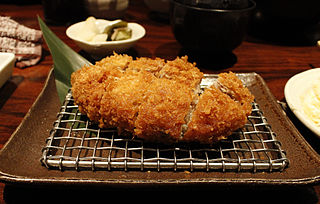
Tonkatsu is a Japanese dish that consists of a breaded, deep-fried pork cutlet. It involves coating slices of pork with panko, and then frying them in oil. The two main types are fillet and loin. Tonkatsu is also the basis of other dishes such as katsukarē and katsudon.

A blood sausage is a sausage filled with blood that is cooked or dried and mixed with a filler until it is thick enough to solidify when cooled. Most commonly, the blood of pigs, sheep, lamb, cow, chicken, or goose is used.

A fried egg is a cooked dish made from one or more eggs which are removed from their shells and placed into a frying pan and fried. They are traditionally eaten for breakfast in many countries but may also be served at other times of the day.

Chorizo is a type of pork sausage originating from the Iberian Peninsula. It is made in many national and regional varieties in several countries on different continents. Some of these varieties are quite different from each other, occasionally leading to confusion or disagreements over the names and identities of the products in question.

A po' boy is a sandwich originally from Louisiana. It almost always consists of meat, which is usually roast beef, chicken fingers or some sort of fried seafood such as shrimp, crawfish, fish, oysters or crab. The meat is served on New Orleans French bread, known for its crispy crust and fluffy center.

A grilled cheese is a hot cheese sandwich typically prepared by heating slices of cheese between slices of bread with a cooking fat such as butter or mayonnaise on a frying pan, griddle, or sandwich toaster, until the bread browns and the cheese melts.

A schnitzel is a thin slice of meat. The meat is usually thinned by pounding with a meat tenderizer. Most commonly, the meat is breaded before frying. Breaded schnitzel is popular in many countries and is made using veal, pork, chicken, mutton, beef, or turkey. Schnitzel is very similar to the dish escalope in France and Spain, panado in Portugal, tonkatsu in Japan, cotoletta in Italy, kotlet schabowy in Poland, milanesa in Latin America, chuleta valluna in Colombia, chicken chop in Malaysia, and chicken-fried steak and pork tenderloin of the United States.

The milanesa is a variation of the Lombard veal Milanese, or the Austrian Wiener Schnitzel, where generic types of meat breaded cutlet preparations are known as a milanesa.
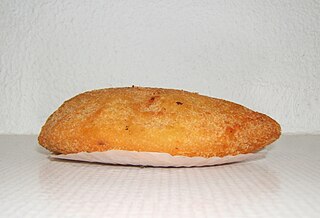
A rissole is a small patty created in France, enclosed in pastry, or rolled in breadcrumbs, usually baked or deep fried. The filling has savory ingredients, most often minced meat, fish or cheese, and is served as an entrée, main course, or side dish.

Migas is a dish traditionally made from stale bread and other ingredients in Spanish and Portuguese cuisines. Originally introduced by shepherds, migas are very popular across the Iberian Peninsula, and are the typical breakfast of hunters at monterías in southern Spain.

A chicken sandwich is a sandwich that typically consists of boneless, skinless chicken breast or thigh, served between slices of bread, on a bun, or on a roll. Variations on the "chicken sandwich" include the chicken burger, chicken on a bun, chicken on a Kaiser , hot chicken, or chicken salad sandwich.

Uruguayan cuisine is a fusion of cuisines from several European countries, especially of Mediterranean foods from Spain, Italy, Portugal and France. Other influences on the cuisine resulted from immigration from countries such as Germany and Scotland. Uruguayan gastronomy is a result of immigration, rather than local Amerindian cuisine, because of late-19th and early 20th century immigration waves of, mostly, Italians. Spanish influences are abundant: desserts like churros, flan, ensaimadas yoo (Catalan sweet bread), and alfajores were all brought from Spain. There are also all kinds of stews known as guisos or estofados, arroces, and fabada. All of the guisos and traditional pucheros (stews) are also of Spanish origin. Uruguayan preparations of fish, such as dried salt cod (bacalao), calamari, and octopus, originate from the Basque and Galician regions, and also Portugal. Due to its strong Italian tradition, all of the famous Italian pasta dishes are present in Uruguay including ravioli, lasagne, tortellini, fettuccine, and the traditional gnocchi. Although the pasta can be served with many sauces, there is one special sauce that was created by Uruguayans. Caruso sauce is a pasta sauce made from double cream, meat, onions, ham and mushrooms. It is very popular with sorrentinos and agnolotti. Additionally, there is Germanic influence in Uruguayan cuisine as well, particularly in sweet dishes. The pastries known as bizcochos are Germanic in origin: croissants, known as medialunas, are the most popular of these, and can be found in two varieties: butter- and lard-based. Also German in origin are the Berlinese known as bolas de fraile, and the rolls called piononos. The facturas were re-christened with local names given the difficult German phonology, and usually Uruguayanized by the addition of a dulce de leche filling. Even dishes like chucrut (sauerkraut) have also made it into mainstream Uruguayan dishes.

Silpancho is a popular Bolivian food from the city of Cochabamba. When prepared properly, this tends to be a large and fulfilling meal with a diversity of carbohydrates and fats. It consists of a base layer of rice, usually white, followed by a layer of boiled and sliced potatoes. Next, a thin layer of pounded meat is followed by a layer of chopped tomato. In addition, onion, beet and parsley are mixed together and topped with either one or two fried eggs.
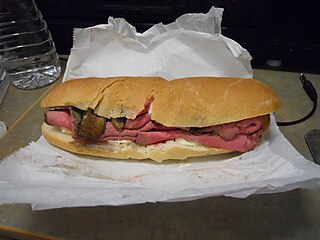
The roast beef sandwich is a sandwich that is made out of sliced roast beef or sometimes beef loaf. It is sold at many diners in the United States, as well as fast food chains, such as Arby's, Rax Roast Beef, and Roy Rogers Restaurants. This style of sandwich often comes on a hamburger bun and may be topped with barbecue sauce and/or melted American cheese. The roast beef sandwich also commonly comprises bread, cold roast beef, lettuce, tomatoes, and mustard, although it would not be uncommon to find cheese, horseradish, fresh/powdered chili pepper and even in some cases red onion. Roast beef sandwiches may be served hot or cold, and are sometimes served open faced.
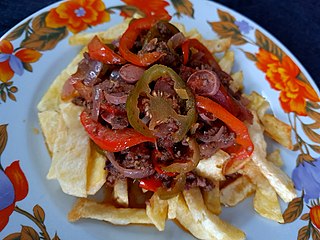
Bolivian cuisine is the indigenous cuisine of Bolivia from the Aymara and Inca cuisine traditions, among other Andean and Amazonian groups. Later influences stemmed from Spaniards, Germans, Italians, French, and Arabs due to the arrival of conquistadors and immigrants from those countries. The traditional staples of Bolivian cuisine are corn, potatoes, quinoa and beans. These ingredients have been combined with a number of staples brought by the Spanish, such as rice, wheat, beef, and pork.

Breaded cutlet or braised cutlet is a dish made from coating a cutlet of meat with breading or batter and either frying or baking it.
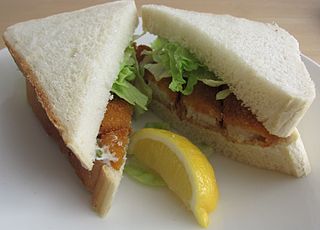
A fish sandwich is, most generally, any kind of sandwich made with fish. The term is frequently used to describe food made with breaded, fried fish, which are commonly found in fast food venues.

















